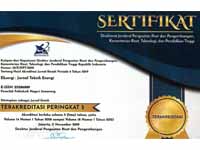HEAT RATE PEMBANGKIT LISTRIK TENAGA UAP PAITON BARU (UNIT 9) BERDASARKAN PERFORMANCE TEST TIAP BULAN DENGAN BEBAN 100%
DOI:
https://doi.org/10.32497/eksergi.v12i2.285Abstract
Heat rate adalah ukuran keandalan dari suatu unit pembangkit. Heat rate didefinisikan sebagai jumlah energi bahan bakar yang dibutuhkan untuk menghasilkan energi listrik sebesar 1 kwh. Tujuan penelitian ini adalah menentukan heat rate suatu unit pembangkit PLTU Paiton Baru (Unit 9) berdasarkan performance test tiap bulan, dari bulan November 2014 hingga Maret 2015. Heat rate dapat ditentukan dengan mengetahui efisiensi boiler metode kerugian panas dan heat rate turbin. Parameter data untuk menentukan nilai heat rate didapatkan dari analisa laboratorium dan ruang kontrol PLTU Paiton Baru (Unit 9). Dari data tersebut dilakukan pengolahan data untuk menentukan nilai heat rate berdasarkan performance test tiap bulan dari bulan November 2014 hingga bulan Maret 2015 pada beban yang sama yaitu sebesar 659 MW. Dari hasil penelitian maka didapatkan Diagram Batang Heat Loss dan Effisiensi Boiler Beban Penuh terhadap waktudan Diagram heat rate terhadap waktu. Dari kedua tersebut dapat disimpukan sebagai berikut Efisiensi boiler tertinggi terjadi pada 26 November 2014 dengan effisiensi sebesar 85,689 %. Sedangkan efisiensi boiler terendah yaitu sebesar 83,280 % terjadi pada 12 Maret 2015. heat rate terendah (terbaik) yaitu2.500,811 kcal/kWh terjadi pada tanggal 13 Januari 2015. Sedangkan heat rate tertinggi terjadi pada tanggal11 Desemmber 2014 yaitu sebesar 2.658,098kcal/kWh.
Kata kunci : heat rate
Downloads
Published
Issue
Section
License
Authors who publish with this journal agree to the following terms:Authors retain copyright and grant the journal right of first publication with the work simultaneously licensed under a Creative Commons Attribution License that allows others to share the work with an acknowledgement of the work's authorship and initial publication in this journal.
Authors are able to enter into separate, additional contractual arrangements for the non-exclusive distribution of the journal's published version of the work (e.g., post it to an institutional repository or publish it in a book), with an acknowledgement of its initial publication in this journal.
Authors are permitted and encouraged to post their work online (e.g., in institutional repositories or on their website) prior to and during the submission process, as it can lead to productive exchanges, as well as earlier and greater citation of published work (See The Effect of Open Access).






